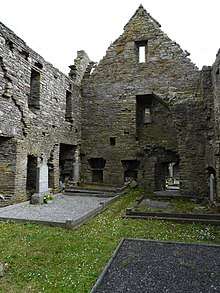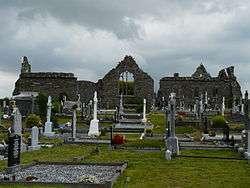Lislaughtin Abbey
| Mainistir Lios Laichtín | |
|
Ruins of the abbey church | |
 Location within Ireland | |
| Monastery information | |
|---|---|
| Other names | Leasa-lauchtin; Lislachtin; Hilleanbegha; Leslaughty[1] |
| Order | Order of Friars Minor |
| Established | 1470–77 |
| Disestablished | 1580 |
| Diocese | Ardfert and Aghadoe |
| People | |
| Founder(s) | John O'Connor, Lord of Iraghticonnor |
| Architecture | |
| Status | Inactive |
| Style | Late Gothic |
| Site | |
| Location | Lislaughtin, Ballylongford, County Kerry |
| Coordinates | 52°33′27″N 9°28′12″W / 52.557367°N 9.469933°WCoordinates: 52°33′27″N 9°28′12″W / 52.557367°N 9.469933°W |
| Visible remains | abbey church (unroofed); dormitory/refectory; collapsed tower; garderobe |
| Public access | yes |
| Official name | Lislaughtin Abbey |
| Reference no. | 258 |
Lislaughtin Abbey is a medieval Franciscan friary and National Monument located in County Kerry, Ireland.[2]
Location
Lislaughtin Abbey is located 1.3 kilometres (0.81 mi) north of Ballylongford, on the east bank of the Ballylongford Creek and to the south of the Shannon Estuary.[3][4][5]
History
The friary was founded for the Order of Friars Minor (Observant Franciscan Friars) in 1470 by John O'Connor, Lord of Kerry Luachra and Iraghticonnor. Permission was granted by Pope Sixtus IV in 1477. It was named after Saint Lachtin (died AD 622) who brought Christianity to the area. A silver processional cross was commissioned in 1479; it is now known as the Lislaughtin or Ballymacasey cross and is held at the National Museum of Ireland – Archaeology.[6][7]
Lord Iraghticonnor was buried at the friary in 1485.[8] Thomas fitz Gerald, heir of the Knight of Glin, was buried there in 1567 after his execution.[9][10]
During the Siege of Carrigafoyle Castle (1580) the abbey was twice raided by English soldiers. The abbey was then dissolved, although the church and graveyard remained in use by the local Catholic population, and some friars returned in 1629.[4] During one of these attacks the Lislaughtin cross was buried for safety, and it was found by a local farmer in March 1871.
Buildings


The abbey church is a long house divided into choir and nave with triple sedilia; the collapsed square tower was over the choir arch.
The thirty windows are pointed and of cut limestone. A two-storey building contained refectory and dormitory. To the northeast is the garderobe.[11]
References
- ↑ Prendergast, John Patrick; Russell, Charles William (10 September 1874). "Calendar of the State Papers, Relating to Ireland, of the Reign of James I. ...: Preserved in Her Majesty's Public Record Office, and Elsewhere". Longman & Company – via Google Books.
- ↑ "Story - Lislaughtin Abbey". dúchas.ie.
- ↑ "Praying Nature at Lislaughtin Abbey, Ballylongford, Co. Kerry". www.praying-nature.com.
- 1 2 "Lislaughtin Abbey is located outside Ballylongford village, Co. Kerry".
- ↑ "Lislaughtin Abbey". ie.geoview.info.
- ↑ "The Lislaughtin (Ballymacasey) Cross - Claddagh Design". www.claddaghdesign.com.
- ↑ Campbell, Gordon (10 September 2017). "The Grove Encyclopedia of Decorative Arts". Oxford University Press – via Google Books.
- ↑ Schreibman, Susan (18 July 2013). "The Life and Work of Thomas MacGreevy: A Critical Reappraisal". A&C Black – via Google Books.
- ↑ Buckley, Christopher (19 May 2015). "But Enough About You: Essays". Simon and Schuster – via Google Books.
- ↑ Tazón, Juan E. (10 September 2017). "The Life and Times of Thomas Stukeley (c.1525-78)". Ashgate Publishing, Ltd. – via Google Books.
- ↑ "Lislaughtin Abbey (Listowel, Ireland): Top Tips Before You Go (with Photos) - TripAdvisor". www.tripadvisor.ie.